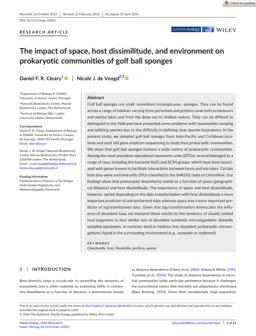2024-06-20
The impact of space, host dissimilitude, and environment on prokaryotic communities of golf ball sponges
Publication
Publication
Marine Ecology , Volume 2024 - Issue e12815
Golf ball sponges are small, sometimes inconspicuous, sponges. They can be found across a range of habitats varying from perturbed and pristine coral reefs to harbours and marine lakes and from the deep sea to shallow waters. They can be difficult to distinguish in the field and have presented some problems with taxonomists lumping and splitting species due to the difficulty in defining clear species boundaries. In the present study, we sampled golf ball sponges from Indo-Pacific and Caribbean locations and used 16S gene amplicon sequencing to study their prokaryotic communities. We show that golf ball sponges harbour a wide variety of prokaryotic communities. Among the most prevalent operational taxonomic units (OTUs), several belonged to a range of taxa, including the bacterial AqS1 and EC94 groups, which have been associated with genes known to facilitate interactions between hosts and microbes. Certain host taxa were enriched with OTUs classified to the SAR202 clade of Chloroflexi. Our findings show that prokaryotic dissimilarity varied as a function of space (geographical distance) and host dissimilitude. The importance of space and host dissimilitude, however, varied depending on the data transformation with host dissimilitude a more important predictor of untransformed data whereas space was a more important predictor of log-transformed data. Given that log-transformation downscales the influence of abundant taxa, we interpret these results by the tendency of closely related host organisms to host similar sets of abundant symbiotic microorganisms; distantly sampled specimens, in contrast, tend to harbour less abundant prokaryotic microorganisms found in the surrounding environment (e.g., seawater or sediment)
| Additional Metadata | |
|---|---|
| , , , , | |
| doi.org/10.1111/maec.12815 | |
| Marine Ecology | |
| Released under the CC-BY 4.0 ("Attribution 4.0 International") License | |
| Organisation | Staff publications |
|
Cleary, Daniel F. R., & de Voogd, N. (2024). The impact of space, host dissimilitude, and environment on prokaryotic communities of golf ball sponges. Marine Ecology, 2024(e12815). doi:10.1111/maec.12815 |
|
